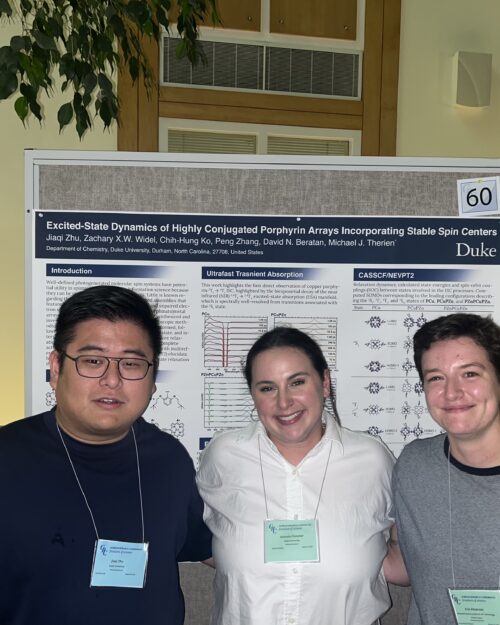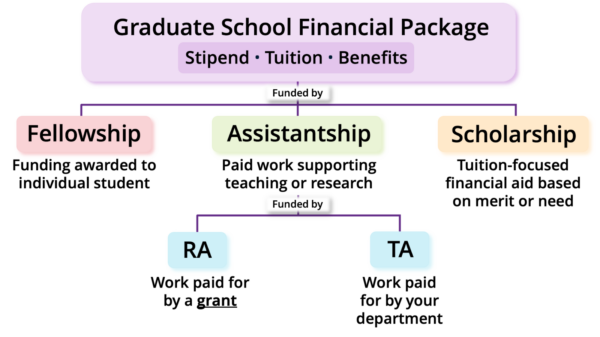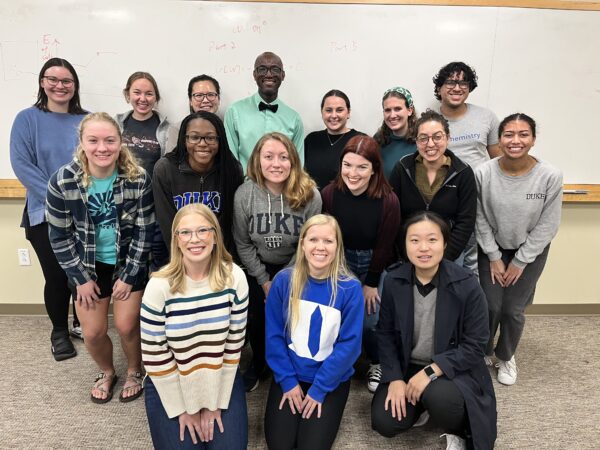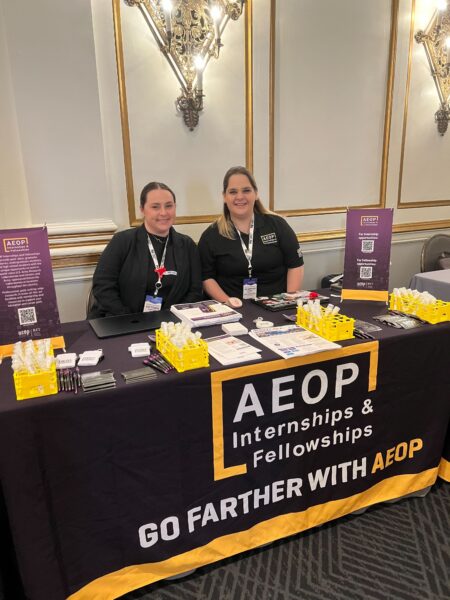August 1, 2025

By Victoria Cinnater, PhD candidate and outreach specialist for AEOP’s Internships and Fellowships program.
In the last blog post, we explored how to determine whether graduate school is the right fit for your goals, including your financial goals. Ironically, one of the more challenging parts of graduate school has nothing to do with courses or research—it’s understanding the finances. In this post, I’ll explain more about the finances of STEM Ph.D. programs so you know what to expect.
First off, did you know you can go to graduate school for free AND get paid?! While many master’s programs do not guarantee funding, most STEM Ph.D. programs provide a financial aid package for their graduate students. But what does that actually mean and where does all that money come from?
What’s in Your Financial Package?
Most STEM Ph.D. programs offer “full funding,” meaning that:
- Tuition is covered.
- Student fees are waived or included. These fees cover access to campus resources like the gym or career services.
- Health insurance is typically required and therefore covered. If you already have insurance, you can opt out of your school’s coverage, and you might even receive a reimbursement. Some programs also cover dental and vision insurance.
- You receive a monthly stipend for living expenses. This is money in your pocket (and it’s typically taxed as income). Stipends vary by institution and location, but can range from $25,000–$50,000 per year.
Tip: when comparing programs, consider the stipend to cost of living ratio – in other words, how far your money will go in any given location.
This funding is typically guaranteed for 4-6 years (the average length of a Ph.D. program), as long as you remain in good academic standing. But who pays for all of this? It can get complicated, but here are the basics.
Types of Funding in a STEM Ph.D. Programs
In graduate school, you’ll hear a lot of terms tossed around, like assistantship, fellowship, grant, or scholarship. It took me a while to understand how all these pieces fit together, and to realize they’re not interchangeable. But, knowing the difference really helped me plan my path and apply for opportunities (and do my taxes) with more confidence. Let’s break it down.

Fellowships
A fellowship is funding given to you, the student, and usually covers the entirety of your financial package at your home institution. If it doesn’t, your department should cover the rest. Fellowship opportunities can be found both within your university or external organizations.
Fellowship applications are highly competitive and usually require a research proposal and a personal statement (this part is important). While the funding agency is supporting your proposed research, they are ultimately funding YOU because they believe in your potential, which often comes with more academic freedom and prestige.
- Check out the Department of Defense’s NDSEG Fellowship (National Defense Science and Engineering Graduate Fellowship Program)!
Another Type of Fellowship: An Important Distinction
While many fellowships fund dissertation research within your home university and lab, some fellowships go beyond that by offering (or requiring) you to conduct research at government agencies, national laboratories, or in industry settings.
- AEOP Internships and Fellowships fall into this category, offering high school students through postdoctoral scholars the opportunity to work in Army research labs and partner labs at universities. These programs provide hands-on experience in real-world research environments, helping participants build valuable skills and connections during their academic and professional journeys.

Grants
A grant, on the other hand, is money awarded to your lab to fund a specific project, usually applied for by the Principle Investigator (PI) of the lab. If your advisor or PI has a grant, they might hire you as a Research Assistant (RA).
Bottom line: grants pay for the science, not the student, but they can indirectly fund your Ph.D. by covering your stipend through RA work. I know, confusing right?
Assistantships
Assistantships are the most common way Ph.D. students earn their stipend. Think of it as working for your funding; you’re contributing to the department or a research project in exchange for financial support.
- Research Assistantship (RA): You assist on a funded research project, often aligned with your dissertation topic.
- Teaching Assistantship (TA): You help teach a course, which might include grading papers, running lab sections, or holding office hours.
Scholarship for Service Programs
Some external organizations offer funding in exchange for future service like teaching, government work, or outreach. This is known as a scholarship for service program.
For example, the Department of Defense’s SMART Scholarship-for-Service Program funds your graduate education in exchange for post-grad civilian employment (no, you are not joining the military) at a Department of Defense laboratory. You could also think of it as a full-ride STEM scholarship with a guaranteed DoD job!
How Do I Know What I’m Getting?
Now that you know what all of these buzzwords mean, be sure to fully understand your funding package and don’t hesitate to ask questions! This package is like a job offer, so you should know exactly what you are getting.
Your funding package offer should clearly state:
- The length of funding guaranteed
- Annual stipend amount
- Type(s) of support (TA, RA, fellowship)
- Health insurance and student fee coverage
- Any expected duties (e.g., TA requirements for funding)
 Navigating the financial landscape of a STEM Ph.D. can feel overwhelming at first, but understanding how funding works is key to making confident, informed decisions about your future. Whether you’re applying soon or just beginning to explore your options, remember: you’re not just choosing a program, you’re accepting a job offer. Additionally, be sure to check whether universities have a graduate student union, as this can influence your stipend, benefits, and overall working conditions.
Navigating the financial landscape of a STEM Ph.D. can feel overwhelming at first, but understanding how funding works is key to making confident, informed decisions about your future. Whether you’re applying soon or just beginning to explore your options, remember: you’re not just choosing a program, you’re accepting a job offer. Additionally, be sure to check whether universities have a graduate student union, as this can influence your stipend, benefits, and overall working conditions.
Most importantly, don’t be afraid to ask questions and weigh your options carefully. In the next post, I’ll share tips for comparing offers and choosing the right program; stay tuned!
*These insights are based on my experience as a Ph.D. candidate in chemistry at a private university with a graduate student union currently in active negotiations. Your experience may vary depending on your institution and field.
Find a Volunteering Opportunity
Visit our Program Volunteers page for a tool to find the best opportunity for you.
